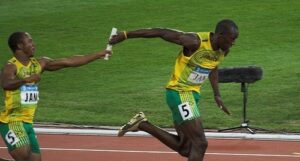Back to: Physical Health Education Primary 4
Welcome to today’s class!!
We are thrilled to have you in our class!!
In today’s Physical Education Class class, we will be focusing on Revision
PHE Revision

We are finally getting closer to that time of the year where your knowledge of what you have been taught so far is tested. Not to fret! This is why revision is important! Let’s rewind to some of the topics we learned from our previous classes.
Locomotive Movements
Before we look at locomotive movement, let’s explain what a movement is.
A movement is an act of change in the position or location of something.
Movement is the natural way of shifting the body from one place to another. Now try shifting yourself from where you are to another. That’s movement!
Some examples of movement are:
- Jogging
- Crawling
- Leaping
- Hopping
- Running
- Walking
On the other hand, Locomotive is the movement of the body from one place to another. The movement can be forward or backward movement.
Examples Of Locomotive Movement include:
- Hopping
- Jumping
- Skipping
- Sliding
- Crawling
- Walking
- Running
- Galloping
In summary, Locomotive movements involve the movement of our bodies from one place to another. The movement can either be forward or backward movement.
Non-locomotive Movements

As we have come to learn from our two previous classes, a movement is an act of change in the position or location of something.
Movement is the natural way of shifting the body from one place to another. Now try shifting yourself from where you are to another. That’s movement!
Some examples of movement are:
- Jogging
- Crawling
- Leaping
- Hopping
- Running
- Walking
On the other hand, Locomotive is the movement of the body from one place to another. The movement can be forward or backward movement.
Examples Of Locomotive Movement include:
- Hopping
- Jumping
- Skipping
- Sliding
- Crawling
- Walking
- Running
- Galloping
As for Non-locomotive movements, they are movements that do not involve travelling from one place to another. There are many examples of non-locomotor movements, which include:
- Bending
- Stretching
- Extending
- Turning
- Raising
- Twisting
- Rotating
- Swinging
- Lifting
- Shaking
- Wiggling
- Pulling
- Dodging
- Pushing
- Swaying
- Flexing
What is an example of a non-locomotor skill?
Examples of non-locomotor skills include:
- A child who stands in place and bends at the waist downward to touch their toes
- A child extending their arms upward as if they were trying to reach the sky
- A child bending their knee upward to march in place
- A child performing a push-up
In summary, movement is the natural way of shifting the body from one place to another.
Middle Distance Races

Middle Distance and Long Distance running races are the track running events which take place over standard distances. Middle Distance includes 800 metres and 1,500 metres while the Long Distance includes 5,000 metres, 10,000 metres and 3,000 metres steeplechase events.
The Middle-distance running events are usually longer than sprints. In these events, the athlete has to run over the fixed distance in the shortest possible time.This type of running requires endurance and pace.
The present two types of events conducted by the International Association of Athletics Federation (“IAAF”) as part of Middle –Distance running are:
- 800 metres
The 800 metres is a common track running event that takes place on a 400 metre outdoor track and is the shortest middle-distance running event. In this event the athlete runs over two laps of the 400 metre track if the event is part of Summer Olympics whereas in Winter Olympics this event is conducted on a 200 metre indoor track and the athlete in this case has to take four laps of the track.
- 1500 metres
The 1500 metres is the prime middle -distance track event in Athletics. This event is equivalent to 1.5 kilometres or approximately 0.93 miles. In the 1500 metre running the athlete runs over three and three-quarter laps around a standard 400 metre track. Athletes make a bunched start and break immediately for the inside lane.
In summary, Middle Distance includes 800 metres and 1,500 metres while the Long Distance includes 5,000 metres, 10,000 metres and 3,000 metres steeplechase events.
Relay Race

It is normal to find a team of four runners running equal distances, generally 100m and 400m each, while passing a baton to one another on a rolling start, in a Relay Race.
A relay race is an event where a team of four athletes run equal predetermined distances in a sprint race, each passing a rod-like object called the ‘baton’ to the next person to continue the race. The last runner in a relay is called the ‘anchor’.
There are also other types of relays – like sprint medley relays (where each runner runs progressively longer distances like 200m, 400m, 800 metres and so on), long distance relays (which have more than five legs) and cross-country relays.
The 4x100m relay is an event where a relay team of four members each run a distance of 100m in a single designated lane.
During each leg run, the athlete has to carry a baton and hand it over to the next team member.
The baton exchange has to happen within a 20m changeover box, located 10m before and 10m after the start of each leg, starting from the second relay runner.
A team can be disqualified if any member drops the baton during the handover or if the handover occurs outside the designated area. The runner finishing the race will generally be the fastest sprinter in a team.
The rules for the 4x400m relay are largely similar to the 4x100m relays.
The team members cover a distance of 400m each before passing on the baton to the next team member, within the same 20m designated changeover area.
However, there is one key difference. While the first member runs 400m in a single designated lane, the subsequent members of a team can interchange lanes starting from the back-straight halfway through the second leg.
In summary, 400m runners compete for the inside line, which is the shortest route to the finish line. In this race, four athletes run equal predetermined distances in a sprint race, each passing a rod-like object called the ‘baton’ to the next person to continue the race.
Evaluation
- What is movement?
- Give five examples of Locomotive Movements.
Reading Assignment
- Give five examples of Non-Locomotive Movement
- Give one example of a Middle Distance Race.
Weekend Assignment
- How many Athletes participate in a Relay Race?
- List three things that are important to have in a Relay Race.
We hope you enjoyed today’s class. In our next class. We can’t wait to see you in the next term!
Let us know your thoughts and questions in the comment section, and we will attend to them as fast as we can.
